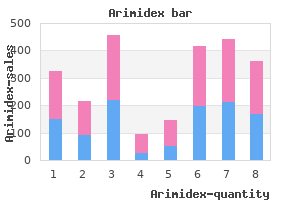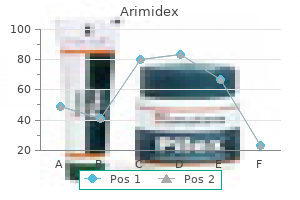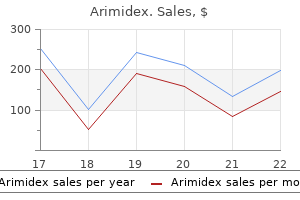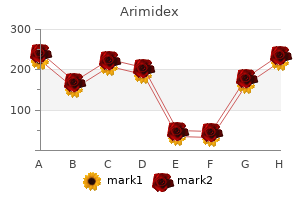"Order 1 mg arimidex amex, women's health clinic balcatta".
I. Urkrass, M.B. B.CH. B.A.O., M.B.B.Ch., Ph.D.
Clinical Director, University of Pittsburgh School of Medicine
This lesion has a necrotic center surrounded by macrophages menopause yahoo articles from yesterday arimidex 1 mg order, encapsulating fibroblasts women's health yearly check up 1 mg arimidex, fibrous connective tissue in the periphery pregnancy glucose test 1 mg arimidex buy fast delivery, and scattered lymphocytes. Microorganisms are usually present only in relatively small numbers in these types of lesions. The disease is self-limited in the majority of patients, and treatment is not required in these cases. Therapy should be considered for (a) patients with impaired cellular immunity; (b) comorbid illnesses that are adversely impacted by the infection, including chronic pulmonary dysfunction, renal failure, and congestive heart failure; and (c) when symptoms and radiographic findings persist for more than 6 to 8 weeks, at which time the disease is considered to be persistent coccidioidal pneumonia and occurs in approximately 1% of patients. Progression to caseous nodules, cavities, and calcified, fibrotic, or ossified lesions indicates complicated or residual stages of coccidioidomycosis. There are several relative indications for surgery in pulmonary coccidioidomycosis. A rapidly expanding (>4 cm) cavity that is close to the visceral pleura is a high risk for rupture into the pleural space and subsequent empyema. Other indications for operative intervention include life-threatening hemoptysis; hemoptysis that is persistent despite medical therapy; symptomatic fungus ball; bronchopleural fistula; cavitary lesions with persistent positive sputum; and pulmonary nodules that degenerate over time. Finally, any nodule with signs that are concerning for malignancy should undergo further evaluation, including biopsy or resection, to determine the underlying etiology. Diagnosis of coccidioidomycosis is confirmed by histopathologic, mycologic, and serologic evaluation. Immunocompromised patients are especially susceptible to disseminated coccidioidomycosis, which carries a mortality rate over 40%. Treatment options for this disease vary depending on the severity of the disease as well as the stage. Amphotericin B deoxycholate or the triazoles continue to be the primary antifungal medications. Blastomyces dermatitidis is a round, single-budding yeast with a characteristic thick, refractile cell wall. Exposure occurs when contaminated soil is disturbed and the conidia are aerosolized. A small minority of patients will develop chronic pulmonary infection or disseminated disease, including cutaneous, osteoarticular, and genitourinary involvement. Symptoms are nonspecific and consistent with chronic pneumonia in 60% to 90% of patients. They include cough, mucoid sputum production, chest pain, fever, malaise, weight loss, and, uncommonly, hemoptysis. In acute disease, radiographs are either completely negative or have nonspecific findings; in chronic disease, fibronodular lesions (with or without cavitation) similar to tuberculosis are noted. Mass lesions similar to carcinoma are frequent, and lung biopsy is frequently used. Over 50% of patients with chronic blastomycosis also have extrapulmonary manifestations, but less than 10% of patients present with severe clinical manifestation. In the absence of therapy, close follow-up is warranted for evidence of progression to chronic or extrapulmonary disease. After adequate drug therapy, surgical resection of known cavitary lesions should be considered because viable organisms are known to persist in such lesions. Most clinicians would agree that losing over a liter of blood via the airway within 1 day is significant, yet use of an absolute volume criterion presents difficulties. First, it is difficult for the patient or caregivers to quantify the volume of blood being lost. For example, the loss of 100 mL of blood over 24 hours in a 40-year-old male with normal pulmonary function would be of little immediate consequence, because his normal cough would ensure his ability to clear the blood and secretions. The lungs have two sources of blood supply: the pulmonary and bronchial arterial systems.

Diseases
- Peters anomaly with cataract
- Hunter Jurenka Thompson syndrome
- Amaurosis
- Gerstmann syndrome
- Mental retardation coloboma slimness
- Trichorhinophalangeal syndrome type I
- Brachycephaly deafness cataract mental retardation

Recurrent cholangitis is common and increases mortality rates beyond what would be expected on the basis of laboratory values menstruation slang arimidex 1 mg purchase overnight delivery. Recurrence is fairly uncommon: studies have reported a recurrence rate of up to 20% at 10 years posttransplant breast cancer earrings proven 1 mg arimidex. Hemochromatosis breast cancer 6 weeks radiation safe 1 mg arimidex, an inherited disorder, results in excessive intestinal iron absorption. Another metabolic disorder, 1-antitrypsin deficiency, is characterized by insufficient levels of a protease inhibitor, resulting in early-onset emphysema and cirrhosis. Resection is the first line of treatment if possible, but often, cirrhosis is too advanced. These criteria were established by a landmark paper in 1996 showing that patients with a single tumor under 5 cm in diameter, or with three tumors under 3 cm in diameter, in the absence of vascular invasion, had a 4-year survival rate of 85%. Transplants for cholangiocarcinoma are still in the experimental stages but may be performed if the center has an experimental protocol in place. The Mayo Clinic protocol, which uses neoadjuvant therapy and strict exclusion criteria, has resulted in a 5-year survival rate of 82%. This devastating illness is defined by acute and severe liver injury with impaired synthetic function and encephalopathy in a person who had normal liver function. The difficulty lies in predicting who will not recover and therefore would benefit from a liver transplant. Such patients suffer from severe coagulopathy, hypoglycemia, lactic acidosis, and renal dysfunction. Cerebral edema, a serious complication of acute liver failure, is a leading cause of death from brain herniation. Intracranial pressure monitoring and serial imaging are often necessary; if a patient develops irreversible brain damage, a transplant is not performed. Recipient Selection the diagnosis of cirrhosis itself is not an indication for a transplant. Patients may have compensated cirrhosis for years such that the traditional indication for a transplant is decompensated cirrhosis, manifested by hepatic encephalopathy, ascites, spontaneous bacterial peritonitis, portal hypertensive bleeding, and hepatorenal syndrome (each described below). Hepatic encephalopathy is an altered neuropsychiatric state caused by metabolic abnormalities resulting from liver failure. As the liver disease progresses, patients can become somnolent and confused and, in the end stages, comatose. Ammonia is produced by enterocytes from glutamine and from colonic bacterial catabolism, and the use of serum ammonia levels as a marker of encephalopathy is controversial because a variety of factors can influence levels. Hyperammonemia suggests worsening liver function and bypass of portal blood flow around the liver. Ascites (the accumulation of fluid in the abdominal cavity) that is caused by cirrhosis is a transudate with a high serum-ascites gradient (>1. Associated with portal hypertension, it is treated initially with sodium restriction and diuretics. The first line of empiric treatment is with a third-generation cephalosporin because the majority of cases are caused by aerobic gram-negative microbes such as E. Portal hypertensive bleeding can be a devastating event for patients with cirrhosis. Each bleeding event carries a 30% mortality rate and accounts for a third of all deaths related to cirrhosis. The initial intervention is endoscopy with sclerotherapy and band ligation of bleeding varices. The last line of treatment is emergency surgery to place a portosystemic shunt, transect the esophagus, or devascularize the gastroesophageal junction (Sugiura procedure). Preventing variceal bleeding is essential and can be achieved, with some success, using -blockers. Hepatorenal syndrome is a form of acute renal failure that develops as liver disease worsens.

However womens health jber arimidex 1 mg buy lowest price, potentially lethal lacerations of internal organs can occur womens health articles order 1 mg arimidex amex, because the net energy transfer to any given location may be substantial breast cancer basketball shoes arimidex 1 mg discount without prescription. In blunt trauma, particular constellations of injury or injury patterns are associated with specific injury mechanisms. For example, when an unrestrained driver sustains a frontal impact, the head strikes the windshield, the chest and upper abdomen hit the steering column, and the legs or knees contact the dashboard. The resultant injuries can include facial fractures, cervical spine fractures, laceration of the thoracic aorta, myocardial contusion, injury to the spleen and liver, and fractures of the pelvis and lower extremities. When such patients are evaluated, the discovery of one of these injuries should prompt a search for the others. Collisions with side impact also carry the risk of cervical spine and thoracic trauma, diaphragm rupture, and crush injuries of the pelvic ring, but solid organ injury usually is limited to either the liver or spleen based on the direction of impact. Not surprisingly, any time a patient is ejected from the vehicle or thrown a significant distance from a motorcycle, the risk of any injury exists. Gunshot wounds are subdivided further into high- and low-velocity injuries, because the speed of the bullet is much more important than its weight in determining kinetic energy. High-velocity gunshot wounds (bullet speed >2000 ft/s) are infrequent in the civilian setting. Close-range shotgun wounds are tantamount to high-velocity wounds because the entire energy of the load is delivered to a small area, often with devastating results. In contrast, long-range shotgun blasts result in a diffuse pellet pattern in which many pellets miss the victim, and those that do strike are dispersed and of comparatively low energy. However, the seriously injured patient is in constant jeopardy when undergoing special diagnostic testing; therefore, the surgeon must be in attendance and must be prepared to alter plans as circumstances demand. Hemodynamic, respiratory, and mental status will determine the most appropriate course of action. With these issues in mind, additional diagnostic tests are discussed on an anatomic basis. Head Evaluation of the head includes examination for injuries to the scalp, eyes, ears, nose, mouth, facial bones, and intracranial structures. Palpation of the head will identify scalp lacerations, which should be evaluated for depth, and depressed or open skull fractures. The eye examination includes not only pupillary size and reactivity, but also examination for visual acuity and for hemorrhage within the globe. Ocular entrapment, caused by orbital fractures with impingement on the ocular muscles, is evident when the patient cannot move his or her eyes through the entire range of motion. It is important to perform the eye examination early, because significant orbital swelling may prevent later evaluation. The tympanic membrane is examined to identify hemotympanum, otorrhea, or rupture, which may signal an underlying head injury. Although such fractures may not require treatment, there is an association with blunt cerebrovascular injuries, cranial nerve injuries, and risk of meningitis. A good question to ask awake patients is whether their bite feels normal to them; abnormal dental closure suggests malalignment of facial bones and a possibility for a mandible or maxillary fracture. Nasal fractures, which may be evident on direct inspection or palpation, typically bleed vigorously. Examination of the oral cavity includes inspection for open fractures, loose or fractured teeth, and sublingual hematomas. Subdural hematomas occur between the dura and cortex and are caused by venous disruption or laceration of the parenchyma of the brain. Due to associated parenchymal injury, subdural hematomas have a much worse prognosis than epidural collections. Hemorrhage into the subarachnoid space may cause vasospasm and further reduce cerebral blood flow. Epidural hematomas (A) have a distinctive convex shape on computed tomographic scan, whereas subdural hematomas (B) are concave along the surface of the brain. Significant intracranial penetrating injuries usually are produced by bullets from handguns, but an array of other weapons or instruments can injure the cerebrum via the orbit or through the thinner temporal region of the skull. Although the diagnosis usually is obvious, in some instances wounds in the auditory canal, mouth, and nose can be elusive.


